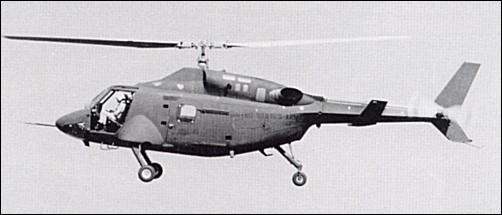
| Bell D-292 ACAP 1953 |  |
 |

| Bell D-292 ACAP 1953 |  |
 |
|
In February 1981 the Army's Applied Technology Laboratory announced that Bell Helicopter and the Sikorsky Aircraft Division of United Technologies had both been awarded contracts for the design, construction, and initial flight testing of composite airframe research helicopters as part of the Advanced Composite Airframe Programme (ACAP). The programme's primary goal is the development of an all-composite helicopter fuselage some twenty-two per cent lighter and seventeen per cent cheaper to build, per production airframe, than conventional machines, yet which will still fulfill all existing military requirements for reliability, ease of maintenance, tolerance to crash and battle damage, and reduced radar signature. Bell and Sikorsky were each awarded contracts for the production of three machines; a tool-proof vehicle, a static test vehicle, and a flight test vehicle. Bell's ACAP machine, which carries the company model number D292, made its first flight in August 1985. By mid-January 1986 the aircraft had completed twelve of its projected fifty flight test hours. The D292 was based on Bell's commercial Model 222 twin- turbine light helicopter and used that machine's Avco Lycoming engines, transmission, and two-bladed main and tail rotors. The ACAP's tailboom, vertical fin, and rotor pylon are almost identical in appearance to those of the 222, though the D292's entire elongated pod-and-boom airframe is constructed of glass-reinforced plastic (GRP), graphite, and Kevlar. The use of a particular composite material for a specific aircraft component is determined by the strength, flexibility or other primary characteristic required of that component. The D292's basic load-bearing structure is thus constructed primarily of graphite or graphite/epoxy, while the flooring and most of the craft's exterior 'skin' is made of a more ballistically-tolerant Kevlar/ epoxy or glassfiber/epoxy blend. The seats for the helicopter's two crew members and two passengers are of Kevlar/epoxy and are designed to absorb the high vertical loads of a forty-foot- per-second crash landing, as are the legs of the craft's non- retracting tailwheel landing gear. Detailed information regarding the D292's performance compared with the Sikorsky S-75 ACAP was not available at the time this book went to press, though it may be assumed that the future of the Bell machine in U.S. military service will be determined by the type's overall performance in all phases of the evaluation. It is also quite probable that the composite airframe materials and building techniques used by Bell and Sikorsky in the development of their respective ACAP machines will be incorporated into the design of the Army's LHX advanced technology helicopter, and almost certainly into the designs of future civil aircraft produced by both firms. S.Harding "U.S.Army Aircraft since 1947", 1990 Under the Army's Advanced Composite Airframe Program (ACAP), Bell Helicopter Textron was one of the two manufacturers (the other being Sikorsky) awarded a contract to design and develop a prototype of an all-composite helicopter. Phase I of this programme, which consisted of the engineering design and design support testing, was completed by the end of 1982. The construction and testing of three airframes (Phase II), began in October 1982. The first airframe was a tool-proofing article (TPA) used for repairability demonstrations and ballistic testing, while the second airframe became the flight-test vehicle (FTV) and accomplished its initial hover flight on 30 August, 1985. In addition to 15 hours of ground running and 50 hours of flight testing, which were completed in October 1985, the D-292 was used for shake testing and controls proof loading. A five-phase militarisation test and evaluation programme (MT&E) began in 1985 and was completed in 1988, following evaluation of undercarriage crashworthiness, lightning protection system, internal acoustics and additional repairability demonstrations. This programme included dropping the helicopter airframe from 12m in September 1987 at the NASA Langley Research Centre to demonstrate the capability of meeting stringent military crash survivability requirements. This included a 15m/s impact velocity at an aircraft attitude of ten degrees roll and ten degrees nose up pitch without any apparent serious injuries to the four dummy occupants (this impact velocity was comparable to a free fall from a three-storey building). Another major advancement demonstrated by the Bell ACAP design during these tests was the fuel system which totally contained the fuel during the drop test, thus reducing the risk of post-crash fires. But the main purpose of the ACAP programme was to achieve the US Army's goal of reducing weight and cost, as well as improving military helicopter characteristics, by demonstrating the application of advanced composite materials. In this sphere, the Bell D-292 featured a weight reduction of 22% in the airframe structure, a 17% saving in cost, survivability in a vertical crash, and reduced radar signature. These comparisons were made possible because Bell and Sikorsky each also designed a duplicate aircraft of current conventional metal construction. Thus the ACAP programme proved successful in meeting its objectives to demonstrate the use of advanced composites in a fully militarized airframe. This fruitful experience was to be used in the development of the future LHX light attack/armed reconnaissance helicopter. A.J.Pelletier "Bell Aircraft since 1935", 1992 * * *
|